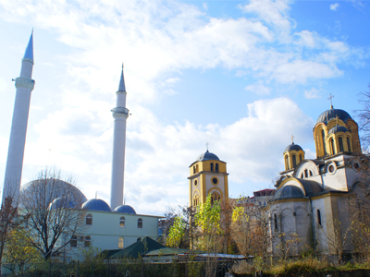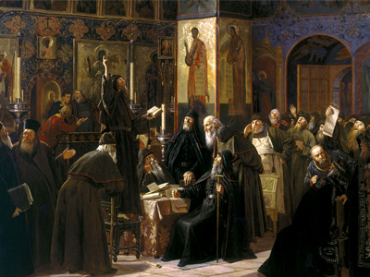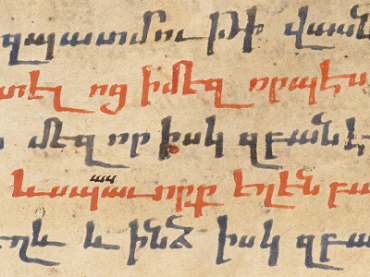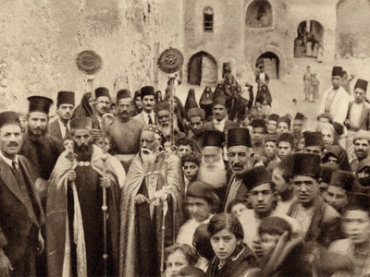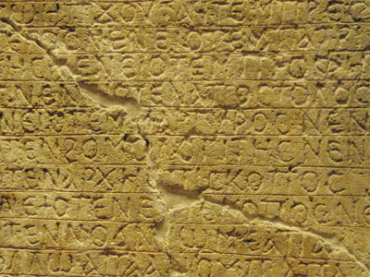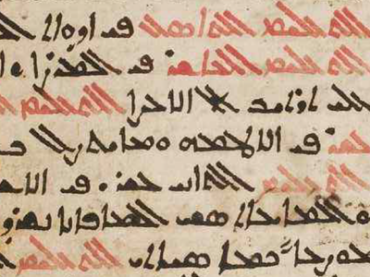Syriac and Eastern Christianity
Hugoye - Journal of Syriac Studies (volume 17)
2014
General Editor George Anton Kiraz
Series: Hugoye: Journal of Syriac Studies 17
ISBN: 978-1-4632-0567-6
Widely regarded as a premier journal dedicated to the study of Syriac, Hugoye: Journal of Syriac Studies was established in 1998 as a venue devoted exclusively to the discipline. An organ of Beth Mardutho, the Syriac Institute, the journal appears semi-annually and will be printed in annual editions. A peer-reviewed journal, Hugoye is a respected academic source for up-to-date information about the state of Syriac studies and for discovering what is going on in the field. Contributors include some of the most respected names in the world of Syriac today.
$75.00
Hugoye - Journal of Syriac Studies (volume 18)
2015
General Editor George Anton Kiraz
Series: Hugoye: Journal of Syriac Studies 18
ISBN: 978-1-4632-0568-3
Widely regarded as a premier journal dedicated to the study of Syriac, Hugoye: Journal of Syriac Studies was established in 1998 as a venue devoted exclusively to the discipline. An organ of Beth Mardutho, the Syriac Institute, the journal appears semi-annually and will be printed in annual editions. A peer-reviewed journal, Hugoye is a respected academic source for up-to-date information about the state of Syriac studies and for discovering what is going on in the field. Contributors include some of the most respected names in the world of Syriac today.
$75.00
Commentaries, Catenae and Biblical Tradition
Papers from the Ninth Birmingham Colloquium on the Textual Criticism of the New Testament, in association with the COMPAUL project
Edited by H. A. G. Houghton
Series: Texts and Studies (Third Series) 13
ISBN: 978-1-4632-0576-8
This collection of original research papers examines early commentaries on the New Testament and the transmission of the biblical text. Focusing principally on Greek and Latin tradition, it provides new insights into the sources and manuscripts of commentators and catenae.
$175.00
Journal of the Canadian Society for Syriac Studies 15
Edited by Amir Harrak
ISBN: 978-1-4632-0569-0
A refereed journal published annually by the Canadian Society for Syriac Studies. This volume includes articles by Daniel Kolligan, Gagik G. Sargsyan, Adam Lehto, Emanuela Braida, Kristian Heal, Narmin 'Ali Amin and Parwan Badri Tawfiq, and Aaron Butts.
$75.00
The Syrian Orthodox Christians in the Late Ottoman Period and Beyond
Crisis then Revival
Series: Gorgias Eastern Christian Studies 43
ISBN: 978-1-4632-0575-1
The book addresses the history of Syrian Orthodoxy during a critical juncture of its history that spans the late Ottoman period and treads well beyond to witness remarkable revival, indeed renaissance. The work uniquely utilizes over 6000 uncatalogued and unpublished archival documents that were made available for it.
$85.00
Seven Icons of Christ
An Introduction to the Oikoumenical Councils
Edited by Sergey Trostyanskiy
Series: Gorgias Handbooks 33
ISBN: 978-1-4632-0572-0
This volume sets out an exposition of the seven key iconic moments of Christian intellectual history that formulate the classical profession of Jesus Christ as the Word of God Incarnate.
$94.00
The History of the ‘Slave of Christ’
From Jewish Child to Christian Martyr
ISBN: 978-1-4632-0573-7
The first critical editions and English translations of the two Syriac recensions of a fascinating text which narrates the story of a young Jewish child, Asher. After converting to Christianity and taking the name ʿAḇdā da-Mšiḥā (‘slave of Christ’), he is martyred by his father. In a detailed introduction, Butts and Gross challenge the use of this text by previous scholars as evidence for historical interactions between Jews and Christians, reevaluating its purpose and situating the story in its Late Antique Babylonian context.
$67.00
2 Maccabees According to the Syriac Peshitta Version with English Translation
Series: Surath Kthob 14
ISBN: 978-1-4632-0587-4
This volume is part of a series of English translations of the Syriac Peshitta along with the Syriac text carried out by an international team of scholars.
$150.00
Reshaping Identities in Late Antique Syria-Mesopotamia
Christian and Jewish Hermeneutics and Narrative Strategies
Series: Judaism in Context 19
ISBN: 978-1-4632-0590-4
This volume presents case studies of the phenomena that contributed to group identity in late antique Syria-Mesopotamia, in particular traditions reflecting interactions between Judaism and Christianity, among various Christian groups, and among other religious traditions of late antiquity (such as Zoroastrianism or 'paganism'). By studying Christian, Jewish and other sources that deal with the establishment, modification and deletion of boundaries, the authors seek to create a frame of reference that will in turn explain and contextualise the existing evidence concerning communication and interaction between highly diverse groups in Late Antiquity.
$151.00
Isaac the Syrian's Spiritual Works
Edited and Translated by Mary T. Hansbury
Series: Texts from Christian Late Antiquity 45
ISBN: 978-1-4632-0593-5
Isaac the Syrian lived the solitary life in the 7th century. He was born in Qatar and subsequently lived in present day Iraq and Iran. After life as a monk, then briefly as a bishop, he withdrew to live the solitary life. These discourses are primarily for solitaries to consolidate them in the love and mercy of God. In this volume, the text of Isaac V has also been included because of the light which it sheds on Apocatastasis, of increasing interest in academic and ecclesial circles.
$90.00
Love, Marriage and Family in Eastern Orthodox Perspective
Edited by Theodore Grey Dedon & Sergey Trostyanskiy
Series: Gorgias Eastern Christian Studies 44
ISBN: 978-1-4632-0596-6
This volume offers an array of theological and sociological studies on Family, Love, and Marriage in the Eastern Orthodox tradition. As new ways of understanding these institutions and concepts emerge in a modern society, this compilation sponsored by the Sophia Institute of Eastern Orthodox Studies incorporates a revisiting of biblical and Patristic understandings as they are received in the wider Orthodox Christian perspective.
$167.00
Diccionario Gorgias Siriaco-Español
By Sebastian P. Brock & George Anton Kiraz; Edición y traducción española de Joan Ferrer & Juan Pedro Monferrer-Sala
Series: Gorgias Handbooks 34
ISBN: 978-1-4632-0600-0
El Diccionario Gorgias Siriaco-Español, basado en el Gorgias Concise Syriac-English, English-Syriac Dictionary de Brock y Kiraz, ha sido concebido como un recurso académico, concebido tanto para el siriaco clásico como para el siriaco literario moderno. A Concise Syriac-Spanish Dictionary. Based on Brock and Kiraz's 2015 Gorgias Concise Syriac-English, English-Syriac Dictionary, it is designed to be a convenient academic resource for Classical Syriac.
$48.00
Jacob of Sarug's Homilies on Praise at Table
Edited and Translated by Jeff W. Childers
Series: Texts from Christian Late Antiquity 46
ISBN: 978-1-4632-0605-5
Part of a series of fascicles containing the bilingual Syriac-English editions of Saint Jacob of Sarug’s homilies, this volume contains his homilies on Praise at Table. These homilies offer a glimpse into the efforts of one late antique author to construct distinctly Christian meaning from the experience of communal meal-sharing. The Syriac text is fully vocalized, and the translation is annotated with a commentary and biblical references. The volume is one of the fascicles of Gorgias Press’s The Metrical Homilies of Mar Jacob of Sarug, which, when complete, will contain all of Jacob’s surviving sermons. Recognized as a saint by both Chalcedonian and non-Chalcedonian Christians alike, Jacob of Sarug (d. 521) produced many narrative poems that have rarely been translated into English. Of his reported 760 metrical homilies, only about half survive.
$47.00
The Works of Cyrillona
Edited and Translated by Carl Griffin
Series: Texts from Christian Late Antiquity 48
ISBN: 978-1-4632-0606-2
Cyrillona (fl. 396) has been ranked among the foremost early Syriac poets since his work was rediscovered by scholars in the mid-19th century. His Holy Week discourses on the Last Supper, the Washing of the Feet, and the Institution of the Eucharist have become particularly well-known to western readers through quotations by such diverse authors as Hugo Rahner and Photina Rech. This volume presents the first modern critical edition of Cyrillona’s Syriac works together with the first complete English translation.
$60.00
Cyrillona
A Critical Study and Commentary
By Carl Griffin
Series: Gorgias Eastern Christian Studies 46
ISBN: 978-1-4632-0607-9
Cyrillona (fl. 396) was a younger contemporary of Ephrem the Syrian whose work has been celebrated as comparable in both beauty and its significance for our understanding of early Syriac Christianity. This study reassesses conventional claims about the author’s identity, date, and the constitution of his corpus. It introduces each of Cyrillona’s five surviving poems and examines their poetic form and genre, structure and rhetorical features, and critical questions of text, interpretation, and theology.
$169.00
From Ancient Manuscripts to Modern Dictionaries
Select Studies in Aramaic, Hebrew, and Greek
Edited by Tarsee Li & Keith Dyer
ISBN: 978-1-4632-0608-6
These articles on Aramaic, Hebrew, and Greek lexicography have arisen from papers presented at the International Syriac Language Project's 14th International Conference in St. Petersburg in 2014.
$211.00
Jacob of Sarug’s Homilies on the Six Days of Creation (The Third Day)
The Third Day
Edited and Translated by Edward G Mathews Jr
Series: Texts from Christian Late Antiquity 47
ISBN: 978-1-4632-0615-4
In this third part of Homily 71, On the Fashioning of Creation, Jacob treats the God's separation of the waters from the earth, and the bringing forth of vegetation on the newly-revealed dry land.
$32.00
The Syriac Order of Monastic Profession and the Order of Baptism
Common Structure, Imagery and Theological Themes
Series: Gorgias Eastern Christian Studies 47
ISBN: 978-1-4632-0619-2
Is monastic profession in the West-Syriac tradition a “second baptism”? A relationship clearly exists between the two rites of initiation in the West-Syriac tradition: the monastic profession and baptism. Aydin examines these two rites of initiation, comparing their external structures, common imagery and theological themes, and reveals that the monastic rite closely parallels, or even is modeled upon, that of baptism. Mor Polycarpus Edip Aydin explores the idea of monastic profession as a “second baptism,” or rather, the realization of what the gift of the Spirit at baptism really implies. An extensive Appendix contains Syriac texts with English translations pertaining to the Syriac rite of monastic profession, with relevant commentaries by Syriac Fathers from the 6th to the 10th centuries.
$128.00
Persian Martyr Acts under King Yazdgird I
Edited and Translated by Geoffrey Herman
ISBN: 978-1-4632-0623-9
This volume presents five vivid tales of Christian martyrs from the fifth century. These accounts thematize the conflict between the martyrs' identity as Persian subjects loyal to the Zoroastrian king and their devotion to Christianity.
$36.00
Journal of the Canadian Society for Syriac Studies 16
Edited by Amir Harrak
ISBN: 978-1-4632-0655-0
A refereed journal published annually by the Canadian Society for Syriac Studies. This volume includes articles by Sidney Griffith, Alexander Treiger, Aaron M. Butts, Jeanie Miller, Gagik G. Sargsyan and Vincent van Vossel.
$75.00
The Chronicle of Zuqnīn
Parts I and II. From the Creation to the Year 506/7 AD
Edited and Translated by Amir Harrak
Series: Gorgias Chronicles of Late Antiquity 2
ISBN: 978-1-4632-0663-5
The Chronicle of Zuqnin is a universal history beginning with the Creation according to the biblical account and ending with the time of the Chronicler, the years 775-776 AD. The author is most probably Joshua the Stylite, a contemporary of the Caliphs al-Mansur and al-Mahdi, who lived in the monastery of Zuqnin that was located near Amid, the Diar-Bakr of modern Turkey. Parts I and II contain compiled sources some of which survived only in this Chronicle. Sources include the Bible, Cave of Treasures, the Sleepers of Ephesus, Eusebius of Caesarea, Socrates, and the short Chronicle called Pseudo-Joshua the Stylite that deals with Sassanian-Byzantine warfare at the begging of the 6th century. Parts III and IV cover the years 488 and 775 AD. In this volume, Parts I and II, including the author’s dedicatory letter, are now published in an updated edition of the Syriac text and the first English translation.
$215.00
Pocket Gorgias Syriac-English Dictionary
Series: Gorgias Handbooks 38
ISBN: 978-1-4632-0707-6
The Pocket Dictionary is both a convenient academic resource and a door into the world of Modern Literary Syriac. With 13,000 entries drawn from the major existing works, it is a practical tool for all but the most specialized Classical Syriac texts.
$45.00
The Julian Romance (revised)
A New English Translation
Edited and Translated by Michael Sokoloff
Series: Texts from Christian Late Antiquity 49
ISBN: 978-1-4632-0708-3
The so-called "Julian Romance" was discovered among the Nitrian manuscripts in the 1830s. This revised edition, with facing Syriac text and English translation, provides a new, more accurate translation of this important Syriac text.
$107.00
An Introduction to Syriac Studies (Third Edition)
Series: Gorgias Handbooks
ISBN: 978-1-4632-0713-7
This Introduction aims to provide basic guidance to important areas of Syriac studies. The relevance of Syriac studies to a variety of other fields is explored. A brief orientation to the history of Syriac literature is offered, and Syriac is set within the context of the other Aramaic dialects. A thorough discussion on important tools (Instrumenta Studiorum) is presented; topics include grammars, dictionaries, the Bible in Syriac, histories of Syriac literature, bibliographical aids and relevant series, periodicals, and encyclopedias. This Introduction should prove useful both for the student beginning Syriac studies and for scholars working in adjacent fields.
$39.00
Jewish Cultural Elements in the Ethiopian Orthodox Täwaḥədo Church
Series: Gorgias Eastern Christian Studies 55
ISBN: 978-1-4632-0717-5
This monograph traces how ‘Jewish’ elements were introduced into and disseminated throughout the Ethiopian Orthodox Täwaḥədo Church through a series of multi-layered, socio-politico-cultural processes. Drawing on historical and literary evidence, Afework tracks the incorporation of Jewish features into the Ethiopian Orthodox Church from pre-Aksumite Christianity, before the fourth century, through the sixteenth century.
$118.00
Filter by
Filter by price
Filter by manufacturer

